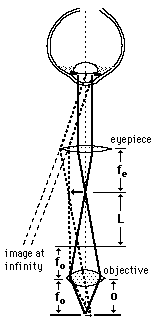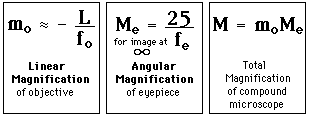
|
Microscope Approximations
The commonly stated expressions for microscope magnification are based on the assumption is that the length of the tube L is large compared to either f(o) or f(e) so that the following relationships hold.

|
The tube length and the objective and eyepiece focal lengths may be changed. This calculation is the standard form which is usually quoted for microscopes, but it is an approximation which may not be a good one under certain circumstances. Obtaining precise magnifications for the assessment of the standard approximations requires application of the lens equation. Forcing the final image to be at infinity requires the real image formed by the objective to be at the focal length of the eyepiece. This means that the image distance for the objective is the tube length minus the eyepiece focal length. Under these constraints, the magnifications become:
|
|
Precise magnifications for compound microscope image at infinity.
|
You can get more magnification from the microscope by adjusting the eyepiece to forming its virtual image closer to the user's eye. If you bring it in to the standard close-focus distance of 25 cm, then applying the lens equation to both objective and eyepiece images gives the following magnifications:
|
|
Precise magnifications for compound microscope image at 25 cm.
|
You can get more magnification from the microscope by focusing it so that the virtual image is at 25 cm rather than infinity, but it is not a good idea because it puts the eye of the viewer under strain to accommodate the eye to that close distance. The relaxed eye is focused at infinity, so if you are going to use a microscope all day, you had better focus it at infinity. Focusing the image close to the eye just because the image is slightly larger is the common "rookie error" in the biology lab, which results in a very fatigued eye after an hour of viewing.
|
Index
Lens concepts
Optical instruments |




